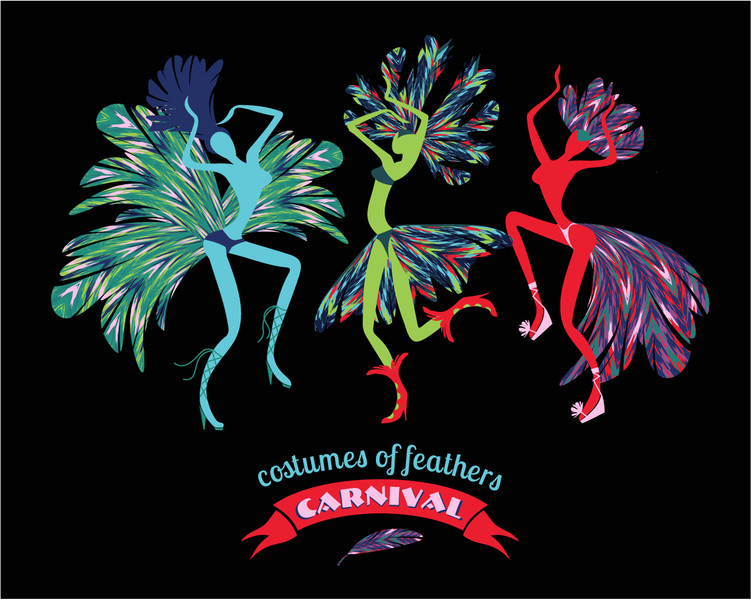The samba is considered to be a celebratory style of dancing in Brazil. With African roots that employ rhythmical and lively movements, there are many types of samba dances just like there are with samba music. With modern samba, the dance incorporates a bunch of elaborate tricks, turns, and acrobatic moves that add a bit of flair to its basic set of figures. The main characteristics of the samba are the fluid swaying motion of the dancers along with rapid steps taken on quarter beats and, of course, the beautiful samba costumes.
History of the Samba
Samba is a dance that originated from the African people in Brazil who brought much of their musical culture and infused it into Latin America’s own. The samba music rhythm has been danced in Brazil since its introduction in the 16th century and has evolved significantly from there. Samba is defined as a set of different dance styles rather than just one since no dance style can be claimed as the original style of samba dancing.
Brazilian samba is mostly danced solo and is popular in celebrations like carnivals. With such a festive mood to its dance patterns, Brazilian samba continues to dominate the samba scene in the country. Ballroom samba on the other hand, is vastly different from Brazilian samba wherein the movements are more graceful and fluid than fun and entertaining. In international-style Latin dancing, the samba is one of the five Latin competition dances.
Samba Action
The samba bounce action is perhaps the most characteristic element of samba. This bounce is what gives the dance a dynamic and powerful feel. Basically, it’s a rhythmic action of flexing the knees slightly on the first half of the beat and then straightening them back on the second half of the beat.
To make the bounce action fluid, samba dancers must keep it effortless and carefree. It should not look forced or exaggerated as it takes away from the gracefulness of the samba dance. The samba bounce is the definitive characteristic of the dance and is mastered by the most elegant of samba dancers.
Distinctive Samba Steps
Basic samba footwork includes three-step weight changes with a slight lift in the knee followed by alternating feet. The rhythm of the dance is "quick, quick, slow”.Distinctive samba steps are as follows:
- Voltas
- Bota fogos
- Kick change
- Samba side steps
- Samba strut
The samba dance ends in a dramatic climax, with the dancers throwing their heads backwards and extending their arms fully to the sides.
Samba Music
The distinctive rhythm of samba is highlighted by its use of original Brazilian instruments such as the tamborim, chocalho, reco-reco, and cabaca. Samba is danced to music with a tempo of about 100 beats per minute. The fast and energetic rhythm of samba music encourages spontaneous dancing, such as in the streets during a Carnival celebration.
A Selection of Sambas
There has never been one definitive samba; the dance is as fluid as the pelvic isolations that keep it hot. Solo samba and partner samba styles work off the same rhythms with fast or slow percussive beats. You just have to concede you know it when you see it.
- Solo Samba - Samba no pé is traditional solo samba dance with simple, recognizable steps spontaneously inspired by the music. It follows a 2/4 count with three steps in every measure, a basic step-ball-change.
- Samba Axé - is a modern variation of the solo dance -- very bouncy with elements of aerobics. Music groups release new songs with choreography tailored to each song as part of a marketing strategy. So samba axé is always changing, with specific moves dependent on the lyrics. Typically, the dance will start slow and progress to a rapid tempo.
- Partner samba - is one of the popular types of Latin dances in ballroom competitions. Before samba became a ballroom dance style, there were original partner samba dances, the most common of which is the Samba gafieira.
- Samba gafieira - is described as a cross between a waltz and a tango. Because it is a more spontaneous dance than the tango, the posture of the dancers is more relaxed. Samba dancers are infectiously happy, not dramatic and intense, but samba gafieira does have some common elements with tango. Originally, the dance was a simple partner dance that drew many of its characteristics from the Brazilian maxixe, a more genteel version of tango that evolved in Brazil as the tango took hold in neighboring Argentina.
- Samba Pagode - is another partner dance, a spin-off from samba party culture that features many elements of ballroom-style samba but can be very showy and athletic, with lots of dips, spins and lifts, depending on the abilities of the dancers.
- Ballroom Samba - In ballroom competitions all around the world, there are dancers dancing the samba. This ballroom version of the samba is different from all of the sambas previously mentioned. The samba in ballroom dancing did not originate in Brazil; of course, the music is samba music, but the style is more Latin ballroom than traditional.
 USD
USD
 EUR
EUR
 AUD
AUD
 GBP
GBP
 SGD
SGD

